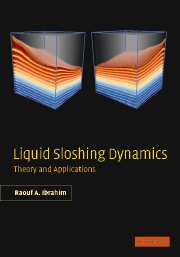Introduction
Published online by Cambridge University Press: 11 August 2009
Summary
Sloshing means any motion of the free liquid surface inside its container. It is caused by any disturbance to partially filled liquid containers. Depending on the type of disturbance and container shape, the free liquid surface can experience different types of motion including simple planar, nonplanar, rotational, irregular beating, symmetric, asymmetric, quasi-periodic and chaotic. When interacting with its elastic container, or its support structure, the free liquid surface can exhibit fascinating types of motion in the form of energy exchange between interacting modes. Modulated free surface occurs when the free-liquid-surface motion interacts with the elastic support structural dynamics in the neighborhood of internal resonance conditions. Under low gravity field, the surface tension is dominant and the liquid may be oriented randomly within the tank depending essentially upon the wetting characteristics of the tank wall.
The basic problem of liquid sloshing involves the estimation of hydrodynamic pressure distribution, forces, moments and natural frequencies of the free-liquid surface. These parameters have a direct effect on the dynamic stability and performance of moving containers.
Generally, the hydrodynamic pressure of liquids in moving rigid containers has two distinct components. One component is directly proportional to the acceleration of the tank. This component is caused by the part of the fluid moving with the same tank velocity. The second is known as “convective” pressure and represents the free-surface-liquid motion. Mechanical models such as mass-spring-dashpot or pendulum systems are usually used to model the sloshing part.
- Type
- Chapter
- Information
- Liquid Sloshing DynamicsTheory and Applications, pp. xvi - xxiiPublisher: Cambridge University PressPrint publication year: 2005

